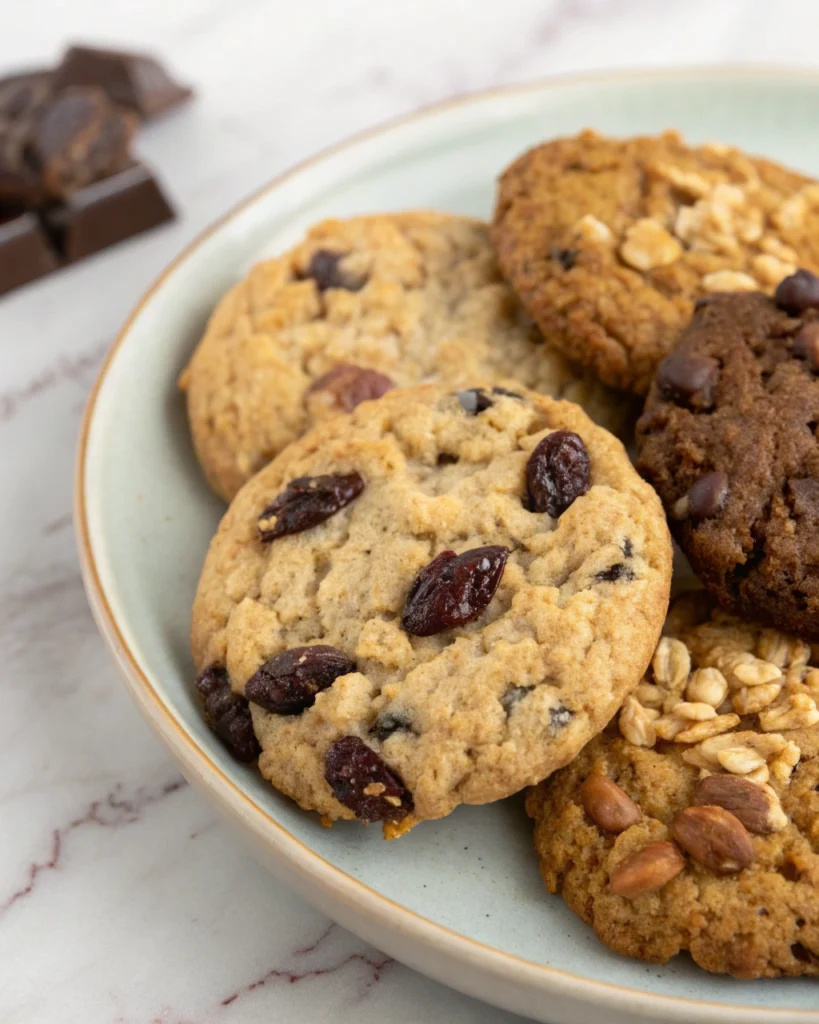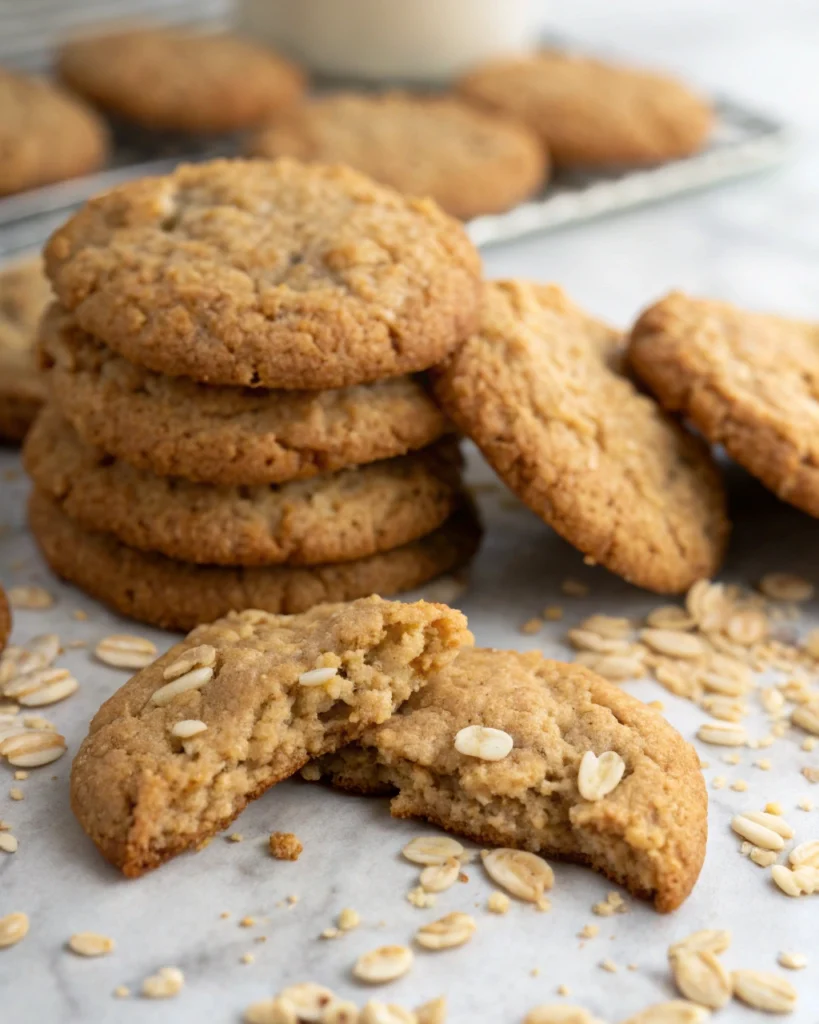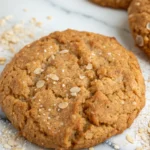If there’s one cookie recipe that’s stood the test of time, it’s the legendary quaker oats oatmeal cookie recipe. These cookies are soft, chewy, and bursting with that cozy, cinnamon-laced flavor we all know and love. Whether you’re baking for a holiday party, your kids’ lunchbox, or just to satisfy a sweet craving, this classic treat always hits the spot.
In this complete guide, we’ll cover everything from selecting the best oats to baking tips that guarantee delicious results. You’ll find variations to spice up the original, expert tricks to avoid cookie flops, and answers to those burning questions like, “Can I use instant oats?” Plus, you’ll get a full breakdown of the nutritional profile and how to make your cookies soft, crispy, or perfectly chewy—just the way you like them. So, let’s roll up our sleeves and dive into the world of sweet, wholesome goodness!
Table of Contents
Introduction to Quaker Oats Oatmeal Cookie Recipe
What Makes Quaker Oats Cookies a Household Favorite?
There’s something magical about biting into a warm oatmeal cookie fresh out of the oven. But what makes the quaker oats oatmeal cookie recipe so beloved? It’s all about that perfect mix of texture and flavor. The oats provide a hearty, chewy bite, while cinnamon and vanilla create a warm, aromatic profile that wraps you in comfort. Unlike overly sweet store-bought options, these homemade cookies strike just the right balance between indulgent and wholesome.
Plus, it doesn’t hurt that this recipe is incredibly adaptable. Want to toss in some raisins? Go for it. Craving chocolate chips or chopped pecans? No problem. Whether you’re going traditional or adding your own twist, this cookie recipe is your blank (and tasty) canvas.
Why You’ll Love This Oatmeal Cookie Recipe
This isn’t just any cookie recipe—it’s the gold standard. Using ingredients you likely already have in your pantry, the quaker oats oatmeal cookie recipe comes together quickly with minimal fuss. Better yet, the dough freezes well, so you can bake a fresh batch whenever the craving hits.
From first-timers to seasoned bakers, anyone can whip up these cookies with confidence. And since they use simple, natural ingredients—no weird stuff—you’ll feel good serving them to friends and family. Let’s be honest, there’s nothing quite like the smell of oatmeal cookies baking to make your kitchen feel like home.
Ingredients Breakdown for the Quaker Oats Oatmeal Cookie Recipe

Core Ingredients and Their Role in the Recipe
The magic of the quaker oats oatmeal cookie recipe lies in its simplicity and perfect balance of ingredients. You don’t need anything fancy to whip up a delicious batch—just a handful of pantry staples, each playing a key role in texture and flavor.
Start with butter or margarine—this adds richness and keeps your cookies moist. Then, mix in a blend of brown sugar and granulated sugar for the ideal sweetness and that slightly crisp edge. One egg helps bind everything together, while vanilla extract brings out the cookie’s deep, comforting flavor.
Next comes the structure: all-purpose flour combined with baking soda for a little lift. Don’t forget the ground cinnamon and a dash of nutmeg—these warm spices take the taste from basic to cozy and nostalgic. And, of course, the star of the show: Quaker® Oats. You can use either quick or old-fashioned oats depending on your desired texture. These oats give the cookie its chewiness and add fiber and whole grains to the mix. You’ll find the official list of ingredients directly from Quaker Oats’ original recipe.
With these ingredients combined, you’ve got the perfect base to build on. From here, you can add raisins, chocolate chips, or chopped nuts if you’re feeling adventurous.
Using Old-Fashioned vs. Quick Oats in Oatmeal Cookies
Both quick and old-fashioned oats work great in the quaker oats oatmeal cookie recipe, but they do affect the texture differently. Quick oats create a more uniform, slightly softer cookie because they absorb moisture faster and blend smoothly into the dough.
Old-fashioned oats, on the other hand, give a chunkier, heartier bite. If you love texture and a rustic feel, this is the way to go. According to many baking experts, like those at Sally’s Baking Addiction, old-fashioned oats add more chew and character.
Whichever you choose, just steer clear of instant oats. They’re too fine and break down too quickly, leading to dry, flat cookies that lack structure.
Substitutions and Dietary Adjustments (Egg-free, Dairy-free Options)
Need to make a few tweaks? No worries! The quaker oats oatmeal cookie recipe is flexible. For an egg-free version, try swapping the egg with a flaxseed or chia seed mix (1 tablespoon seeds + 3 tablespoons water, rested for 5–10 minutes). As for butter, use a plant-based margarine or coconut oil for a dairy-free option.
You can even use gluten-free flour blends if needed, just make sure they contain a binder like xanthan gum for structure. With the right adjustments, everyone can enjoy a batch of these wholesome cookies—without sacrificing flavor or texture.
Step-by-Step Quaker Oats Oatmeal Cookie Recipe Instructions

Preparation: Mixing, Measuring, and Preheating
Ready to bake? First things first—preheat your oven to 375°F (190°C). While that’s heating up, grab two mixing bowls. In one, cream together softened butter and both sugars until smooth and fluffy. This sets the stage for that irresistible cookie texture.
Now, beat in the egg and vanilla extract until everything’s well blended. In the second bowl, mix your dry ingredients: flour, baking soda, salt, cinnamon, and nutmeg. Slowly combine the dry mixture with the wet, stirring just until incorporated. Don’t overmix—this can toughen your cookies.
Finally, fold in your Quaker® Oats. If you’re adding extras like raisins or chocolate chips, now’s the time.
How to Bake for Soft, Chewy, or Crisp Oatmeal Cookies
Once your dough is ready, drop spoonfuls onto an ungreased baking sheet, spacing them about two inches apart. For chewy cookies, bake for 8 to 9 minutes. Want them crisp? Let them go for 10 to 11 minutes instead.
After baking, let the cookies sit on the sheet for a minute or two to firm up. Then, move them to a wire rack to cool completely. Trust us—don’t skip this step. It makes a big difference in texture!
And here’s a pro tip: if you’re baking multiple batches, chill your dough between rounds. This helps keep the cookies from spreading too much.
Storage and Cooling Tips for Best Freshness
Once your cookies are cool, store them in an airtight container. They’ll stay fresh at room temperature for up to a week. To keep them extra soft, toss a slice of bread into the container—it’ll work like magic.
If you’re prepping ahead, the dough freezes well. Scoop into portions, freeze on a tray, and transfer to a zip-top bag. That way, you can bake off just a few cookies whenever the craving hits.
No matter how you store or serve them, the quaker oats oatmeal cookie recipe delivers every time. Classic, cozy, and endlessly comforting.
Tips, Tricks & Troubleshooting the Quaker Oats Oatmeal Cookie Recipe

Common Mistakes and How to Fix Them
Even though the quaker oats oatmeal cookie recipe is beginner-friendly, there are a few common slip-ups you’ll want to dodge. For starters, don’t overmix the dough—this can make your cookies tough. Instead, mix just until everything is combined. If the dough feels too sticky, pop it in the fridge for 20 minutes before scooping. This helps the cookies hold their shape better while baking.
Using the wrong oats is another biggie. While it’s tempting to grab instant oats for convenience, they tend to absorb too much moisture and break down too fast. This leads to flat, crumbly cookies. Stick to quick or old-fashioned oats for the best texture.
Lastly, keep an eye on your bake time. Pulling cookies out too early can leave them undercooked in the middle. On the flip side, baking too long dries them out. So, find that sweet spot and use a timer!
Texture Control: Achieving Chewy vs. Crispy Cookies
Texture is everything when it comes to oatmeal cookies. If you prefer a chewy bite, bake them for 8 to 9 minutes and use brown sugar generously. The moisture from the brown sugar keeps them soft and dense. A little cornstarch in the dough (just 1 teaspoon) can also help you get that bakery-style chewiness.
Want something with more crunch? Bake your cookies a bit longer—10 to 11 minutes should do the trick. Adding a touch more granulated sugar and spreading the dough slightly on the baking sheet helps them crisp up beautifully.
And don’t forget the cooling phase. Cookies continue to bake on the sheet after you take them out, so always let them rest for at least a minute or two before transferring them to a wire rack.
Popular Variations on the Quaker Oats Oatmeal Cookie Recipe

Add-ins: Raisins, Chocolate Chips, Nuts, and More
Once you’ve nailed the classic quaker oats oatmeal cookie recipe, the fun really begins. This dough is a perfect base for all kinds of add-ins. Toss in a cup of raisins or dried cranberries for a naturally sweet, chewy twist. Or go bold with chocolate chips—dark, semi-sweet, or even white chocolate all work beautifully.
If you love some crunch, chopped walnuts, pecans, or almonds can take your cookie game to the next level. Just make sure your total mix-ins don’t exceed 1.5 cups, or your dough might not hold together well. For a tropical spin, try shredded coconut and dried pineapple.
And here’s a tip: lightly dust your add-ins with a bit of flour before mixing them into the dough. This helps distribute them evenly and prevents them from sinking during baking.
Flavor Boosters: Cinnamon, Nutmeg, and Vanilla
Sometimes it’s the little things that make a big impact. The base quaker oats oatmeal cookie recipe includes cinnamon and nutmeg, but feel free to adjust the spice levels to suit your taste. Want a bolder flavor? Add a pinch of ground ginger or allspice. For a cozy fall twist, try a touch of clove or pumpkin pie spice.
Vanilla extract is a must—it deepens the overall flavor and ties everything together. If you’re out of vanilla, almond extract is a fun substitute, but use it sparingly because it’s much stronger.
These small tweaks allow you to customize your cookies without straying too far from the nostalgic original. Whether you’re going spicy, sweet, or nutty, there’s a variation for everyone.
How to Make Bar Cookies with the Same Dough
If you’re short on time or baking for a crowd, bar cookies are a brilliant option. Simply press the dough into a greased 13×9-inch pan and bake at 375°F for about 25 to 30 minutes. Let the bars cool completely before cutting them. This method delivers all the flavor with half the fuss.
Bar cookies also hold up well for lunchboxes and bake sales, making them a great go-to for busy weeks. You can even layer them with chocolate chips, nuts, and a drizzle of caramel for a fun dessert bar twist.
For more delicious recipes, check out our oatmeal cream pie recipe—a soft, nostalgic treat that pairs perfectly with these classic cookies.
Health and Nutrition Information

Calorie Count and Nutritional Value
Don’t let the word “cookie” fool you—there’s a surprising amount of goodness packed into the quaker oats oatmeal cookie recipe. Each cookie contains around 130 calories, depending on your portion size and choice of add-ins. While they are a treat, the oats provide a nice boost of fiber and whole grains, which help you feel full longer and support healthy digestion.
Thanks to the oats, you’ll also get small amounts of essential nutrients like iron, magnesium, and thiamin. Add-ins like raisins or nuts can even boost the vitamin and mineral count. Of course, sugar and fat are part of the mix too, but when enjoyed in moderation, these cookies can fit nicely into a balanced diet.
Compared to heavily processed store-bought options, homemade oatmeal cookies let you control every ingredient. That means fewer preservatives and more real, wholesome goodness. If you’re watching your intake, consider reducing the sugar slightly or using a mix of whole wheat flour for added nutrition.
Whole Grain Benefits of Quaker Oats
One of the biggest perks of the quaker oats oatmeal cookie recipe is its use of oats—pure, hearty, whole grains. Oats are known for being heart-friendly and rich in beta-glucan, a soluble fiber that helps lower cholesterol levels. They also help steady blood sugar, especially when paired with protein or healthy fats.
Including oats in your dessert might seem unusual, but it’s a smart move. They turn an ordinary cookie into a more nourishing snack. And let’s be honest—if you’re going to enjoy a cookie, it might as well offer something back, right?
So the next time you reach for the mixing bowl, feel good knowing you’re baking something that’s just a little better for you than the average sweet.
FAQs
Can I use Quaker oats for cookies?
Absolutely! In fact, that’s what makes the quaker oats oatmeal cookie recipe iconic. Quaker oats—whether quick or old-fashioned—are the heart and soul of this cookie. They create the chewy texture we all love while adding subtle flavor and extra nutrition. Just make sure you’re using the right type; steel-cut oats won’t work here.
Can I use instant oatmeal for oatmeal cookies?
Technically, yes—but it’s not ideal. Instant oats are cut finer and tend to break down too much during mixing and baking. This can result in mushy cookies that lack structure. For the best results, stick with quick oats or old-fashioned rolled oats.
Are Quaker oats good for baking?
Yes, and not just in cookies! Quaker oats are a staple in many baked goods—from muffins to granola bars. They’re mild in flavor, easy to work with, and bring in plenty of fiber. In cookies, they help create that perfect bite between soft and chewy.
Can you make oatmeal cookies with old-fashioned oats?
Definitely. In fact, many bakers prefer old-fashioned oats in the quaker oats oatmeal cookie recipe for their heartier texture and rustic look. They don’t absorb as much moisture as quick oats, so the cookies often come out a bit thicker and more chewy.
Why can’t you use instant oats in cookies?
Instant oats are too thin and too processed. They absorb liquid quickly and turn to mush when mixed into the dough. This changes the consistency and can make your cookies flat and dense. If texture matters to you, skip the instant oats.
What kind of oatmeal is best for baking cookies?
For classic oatmeal cookies, quick oats and old-fashioned oats are both great choices. Quick oats offer a more uniform, softer bite, while old-fashioned oats give you chew and structure. Ultimately, it comes down to preference, but either works beautifully in the quaker oats oatmeal cookie recipe.
Conclusion: Why the Quaker Oats Oatmeal Cookie Recipe Still Reigns Supreme
Timeless Appeal of the Quaker Oats Cookie
Some recipes never go out of style, and the quaker oats oatmeal cookie recipe is a shining example. Its rich, warm flavor, chewy texture, and simple ingredients keep it a favorite in kitchens everywhere. Whether you stick to the classic or spice it up with your own twist, these cookies always bring comfort and joy to the table.
Thanks to its adaptability, this recipe suits every season and occasion. From holiday trays to quick weekday snacks, there’s always a good reason to bake a batch. Plus, the added nutritional benefits of oats mean you can feel just a bit better about reaching for that second cookie.
Final Thoughts and Encouragement to Try the Recipe
If you’ve never tried the quaker oats oatmeal cookie recipe, now’s the time. It’s easy enough for beginners and beloved by baking pros alike. With a few pantry staples and a little love, you’ll have warm, golden cookies ready in no time.
So go ahead—preheat that oven, scoop your dough, and get ready for the sweet smell of fresh-baked oatmeal cookies to fill your kitchen. You might just find your new favorite recipe. And once you do, don’t forget to share a few (or not—we won’t judge!).
Looking for more cookie inspiration? Check out our oatmeal cream pie recipe for another comforting classic with a creamy twist.
Print
quaker oats oatmeal cookie recipe
- Total Time: 20 minutes
- Yield: 36 cookies
Description
This classic quaker oats oatmeal cookie recipe delivers soft, chewy, golden cookies packed with hearty oats, warm spices, and just the right touch of sweetness. Perfect for snacks, lunchboxes, or holiday trays!
Ingredients
– 1 1/4 cups (2 1/2 sticks) unsalted butter, softened
– 3/4 cup firmly packed brown sugar
– 1/2 cup granulated sugar
– 1 large egg
– 1 teaspoon vanilla extract
– 1 1/2 cups all-purpose flour
– 1 teaspoon baking soda
– 1 teaspoon ground cinnamon
– 1/4 teaspoon ground nutmeg
– 1/2 teaspoon salt (optional)
– 3 cups Quaker® Oats (quick or old-fashioned, uncooked)
Add-ins (optional):
– 1 cup raisins, chopped nuts, or chocolate chips
Instructions
1. Preheat oven to 375°F (190°C).
2. In a large mixing bowl, cream together the softened butter, brown sugar, and granulated sugar until smooth and fluffy.
3. Beat in the egg and vanilla until well combined.
4. In a separate bowl, whisk together the flour, baking soda, cinnamon, nutmeg, and salt.
5. Gradually add the dry ingredients to the wet ingredients, mixing just until combined.
6. Stir in the oats, and if using, fold in your choice of add-ins like raisins or chocolate chips.
7. Drop the dough by rounded tablespoonfuls onto an ungreased baking sheet, spacing 2 inches apart.
8. Bake for 8–9 minutes for chewy cookies or 10–11 minutes for crisp cookies.
9. Let the cookies cool on the baking sheet for 1 minute before transferring them to a wire rack to cool completely.
10. Store in an airtight container at room temperature for up to one week.
- Prep Time: 10 minutes
- Cook Time: 10 minutes
- Category: Dessert
- Cuisine: American
Nutrition
- Calories: 130 kcal
- Protein: 2g
Keywords: quaker oats oatmeal cookie recipe, oatmeal cookies, chewy oatmeal cookies, classic cookie recipe, easy cookie recipe
Did you make this recipe?
There are no reviews yet. Be the first one to write one.

